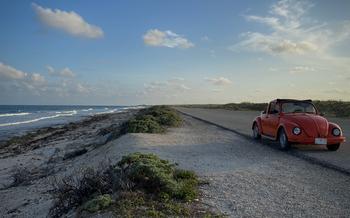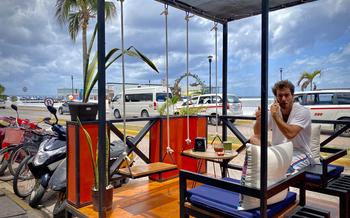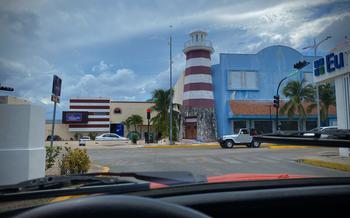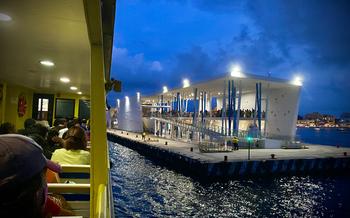
Playa Corona/Chankanaab Shallows
- The Enchanting Underwater Kingdom of Cozumel
- Advanced Snorkeling Techniques
- Marine Life Encounters
- Coral Reef Conservation
- Historical and Cultural Significance
- Snorkeling Tours and Operators
- Packing List for Snorkeling
- Snorkeling Etiquette: Respecting the Marine Environment and Fellow Snorkelers
- Snorkeling with Children
- Snorkeling for Photographers
- Insider Tip:
The Enchanting Underwater Kingdom of Cozumel
Cozumel, a picturesque island off the coast of Mexico, is renowned for its mesmerizing marine life and vibrant coral reefs. The island's underwater world is a kaleidoscope of colors, teeming with a diverse array of tropical fish, graceful sea turtles, and majestic rays. Snorkeling in Cozumel offers an unparalleled opportunity to immerse yourself in this enchanting underwater kingdom and witness the wonders of the sea firsthand.
The marine ecosystem of Cozumel is not only breathtakingly beautiful but also incredibly fragile. It is essential to respect and preserve this delicate environment while exploring its wonders. By choosing a responsible tour operator and following proper snorkeling etiquette, you can help protect the marine life and ensure that future generations can enjoy the same awe-inspiring experience.
Cozumel's rich history is deeply intertwined with the sea. The ancient Mayan civilization, who inhabited the island for centuries, had a profound connection to the ocean. They revered the sea as a sacred source of life and sustenance, using coral reefs for fishing, navigation, and religious ceremonies. Snorkeling in Cozumel allows you to glimpse into this ancient Mayan world and appreciate their deep respect for the marine environment.
Advanced Snorkeling Techniques
As you become more comfortable with snorkeling, you may want to enhance your skills and explore new challenges. Here's how you can improve your snorkeling techniques and take your underwater adventures to the next level:
-
Streamline Your Body: Pay attention to your body position in the water. Keep your body straight, with your head down and your arms and legs close to your body. This streamlined position will reduce drag and allow you to move through the water more efficiently.
-
Perfect Your Flutter Kick: Master the flutter kick, which is the most efficient way to propel yourself through the water while snorkeling. Keep your legs straight and close together, and kick your feet up and down in a continuous motion. Your kicks should be small and quick, not big and slow.
-
Snorkel in Deeper Waters: Once you feel confident in your skills, venture into deeper waters. Deeper waters often offer better visibility and a chance to encounter different marine life. Start slowly and gradually increase the depth as you become more comfortable.
-
Underwater Photography and Videography: If you're passionate about capturing your underwater experiences, consider learning underwater photography or videography. Choose a camera that is suitable for underwater use and learn the basics of underwater photography, such as adjusting camera settings and using natural light effectively.
-
Snorkeling with Marine Mammals: For an unforgettable experience, try snorkeling with marine mammals such as dolphins or whales. Remember to respect their space and follow proper guidelines for interaction. These gentle creatures are often curious and may approach you if you remain calm and respectful.
-
Buoyancy Control and Weighting: Advanced snorkelers should master buoyancy control and proper weighting. Learn how to adjust your buoyancy using your breath and a weight belt. Proper weighting will allow you to maintain neutral buoyancy, making it easier to move through the water and conserve energy.
Marine Life Encounters
The underwater world of Cozumel is teeming with an incredible diversity of marine life, offering snorkelers the chance to encounter a wide range of fascinating creatures in their natural habitat. From vibrant schools of colorful fish darting through the coral reefs to graceful sea turtles gliding effortlessly through the water, the marine life of Cozumel is sure to captivate and amaze. Snorkelers may also encounter playful rays, majestic sharks, and even dolphins and whales during their underwater adventures. Each marine species exhibits unique behaviors and characteristics, making every encounter a special and memorable experience. However, it is important to remember that these animals are wild creatures and should be respected and observed from a distance. Snorkelers should avoid touching or disturbing marine life and should follow proper snorkeling etiquette to minimize their impact on the fragile marine environment.
Coral Reef Conservation
Coral reefs are among the most valuable and biodiverse ecosystems on Earth, providing habitat for a vast array of marine life, supporting fisheries, and protecting coastlines from erosion and storm surges. Unfortunately, coral reefs are facing numerous threats, including climate change, pollution, and overfishing.
Climate change is causing ocean temperatures to rise, which can lead to coral bleaching and death. Pollution, such as chemicals and plastics, can also damage coral reefs. Overfishing can reduce the number of herbivores that eat algae, which can lead to an overgrowth of algae that can smother corals.
Sustainable tourism practices can help to protect coral reefs. Avoiding contact with corals, using reef-safe sunscreen, and supporting conservation initiatives are all ways that tourists can help to preserve these delicate ecosystems.
One of the most important things you can do to help protect coral reefs is to get involved in conservation efforts. You can volunteer for reef cleanups, support research and education programs, and advocate for policies that protect marine ecosystems. By working together, we can help to ensure that future generations can enjoy the beauty and wonder of coral reefs.
Historical and Cultural Significance
Cozumel holds a deep connection to the ancient Mayan civilization, who revered the sea as a sacred and vital part of their existence. The Mayans utilized the coral reefs for fishing, navigation, and religious ceremonies, leaving behind a rich legacy that can still be explored today.
Cozumel's strategic location made it a crucial trading hub, where merchants from across the Mayan world gathered to exchange goods and ideas. The island's strategic location allowed the Mayans to establish trade routes with other Mesoamerican civilizations, leading to cultural exchange and the spread of knowledge.
The modern-day Maya people, who still call Cozumel home, continue to honor their ancestors' traditions and beliefs, maintaining a deep connection to the marine environment. Visitors to Cozumel can learn about Mayan culture and history through guided tours, museum visits, and interactions with local Maya communities, gaining insights into the rich cultural heritage that shapes the island's identity.
Snorkeling Tours and Operators
Cozumel offers a wide range of snorkeling tours, catering to different preferences, skill levels, and budget. Group tours are a great option for those looking for a budget-friendly and social experience. These tours typically include a boat trip to several snorkeling spots, with a guide leading the group and pointing out interesting marine life. Private tours offer a more personalized experience, with a dedicated guide and the flexibility to customize the itinerary based on your interests and skill level.
When choosing a snorkeling tour operator, consider factors such as safety record, experience, group size, and tour itinerary. Look for operators that are certified by reputable organizations like PADI or SSI, and that have a good reputation for safety and customer service. Consider the group size, as smaller groups often offer a more intimate and personalized experience. Finally, compare tour itineraries to find one that includes the snorkeling spots you are most interested in visiting.
Packing List for Snorkeling
When packing for a snorkeling trip to Cozumel, it's essential to bring the right gear to ensure a comfortable and safe experience. Here's a list of essential items to pack:
- Swimwear: Choose a comfortable and well-fitting swimsuit that won't restrict your movement in the water.
- Rash guard or wetsuit: A rash guard or wetsuit can protect your skin from the sun and help you stay warm in cooler waters.
- Sunscreen: Apply reef-safe sunscreen liberally to protect your skin from the sun's harmful rays.
- Sunglasses: Polarized sunglasses can help reduce glare and improve visibility underwater.
- Hat: A hat with a brim can provide additional sun protection for your face and neck.
In addition to these essentials, you may also want to consider bringing the following items:
- Waterproof camera: Capture your underwater adventures with a waterproof camera or action camera.
- Underwater flashlight: An underwater flashlight can be helpful for exploring dimly lit areas or taking photos and videos at night.
- Small first-aid kit: Pack a small first-aid kit with basic supplies to treat minor injuries.
To avoid overpacking, pack efficiently and only bring essential items. Consider using packing cubes to organize your belongings and save space. Remember to protect your belongings from water damage by using waterproof bags or containers.
Snorkeling Etiquette: Respecting the Marine Environment and Fellow Snorkelers
Snorkeling is an activity that allows us to explore the underwater world and interact with marine life in a unique way. However, it is essential to remember that we are guests in this fragile ecosystem, and we must behave responsibly to protect the environment and show respect for other snorkelers.
Proper Etiquette: - Respect Other Snorkelers: Avoid swimming too close to others, and be mindful of your fins and equipment to prevent accidental collisions. - Do Not Touch or Disturb Marine Life: Marine creatures are easily stressed by human contact. Avoid touching, chasing, or feeding marine life, as this can disrupt their natural behavior and cause them harm. - Avoid Removing Anything from the Reef: The coral reef is a delicate ecosystem that takes centuries to grow. Do not remove any coral, shells, or other natural objects from the reef, as this can damage the ecosystem and deprive future generations of its beauty.
Safe Distance from Marine Animals: - Maintain a Safe Distance: Always maintain a safe distance from marine animals, especially those that are known to be dangerous or easily startled. This will help prevent accidental encounters and protect both you and the animals. - Do Not Feed or Harass Animals: Feeding or harassing marine animals can disrupt their natural behavior and make them dependent on humans for food. Avoid any actions that could cause stress or harm to the animals.
Minimize Environmental Impact: - Use Eco-Friendly Sunscreen: Many traditional sunscreens contain chemicals that can harm coral reefs and marine life. Opt for reef-safe sunscreen that is free of oxybenzone and octinoxate. - Avoid Littering: Dispose of trash properly in designated bins or take it with you when you leave. Littering can pollute the water and harm marine life. - Respect Designated Snorkeling Zones: Snorkeling zones are designated to protect marine life and ensure the safety of snorkelers. Stay within these designated areas to avoid disturbing sensitive habitats.
Setting a Positive Example: By following these snorkeling etiquette guidelines, you can help protect the marine environment, ensure the safety of yourself and others, and set a positive example for other snorkelers. Remember, snorkeling is a privilege that allows us to witness the wonders of the underwater world. Let's all do our part to preserve this fragile ecosystem for future generations.
Snorkeling with Children
Introducing children to the wonders of the underwater world through snorkeling can be a magical and memorable experience. Here are some tips to make snorkeling with children fun, safe, and educational:
Start Early: The ideal age to introduce children to snorkeling is between 6 and 8 years old, when they have the physical coordination and maturity to handle the equipment and follow safety instructions.
Choose the Right Spot: Select a snorkeling location with calm waters, good visibility, and a sandy or gently sloping entry point. Avoid areas with strong currents or waves.
Use Proper Equipment: Ensure that your child has properly fitted snorkeling gear, including a mask, snorkel, and fins. Make sure the mask fits snugly without leaking and that the snorkel is the right size for your child's mouth.
Provide Supervision: Always supervise children closely while they are snorkeling. Stay within arm's reach and be prepared to assist them if needed.
Teach Basic Safety Rules: Explain basic safety rules to your child, such as staying within designated areas, avoiding touching or disturbing marine life, and not removing anything from the reef.
Make it Fun: Snorkeling should be an enjoyable experience for children. Play games, point out interesting marine life, and encourage them to explore the underwater world.
Be Patient: Children may need time to adjust to snorkeling and may experience initial fear or discomfort. Be patient and encouraging, and help them overcome their fears gradually.
Create Lasting Memories: Capture the excitement of your child's snorkeling adventure by taking photos and videos. These memories will be cherished for years to come.
Snorkeling for Photographers
For those who love to capture the beauty of the underwater world, snorkeling in Cozumel offers incredible opportunities for photography. With its crystal-clear waters and vibrant marine life, you'll have ample chances to take stunning photos and videos that will transport you back to your magical snorkeling adventures.
Tips for Underwater Photography:
-
Choose the Right Camera and Equipment: Invest in a good quality underwater camera that can withstand the rigors of saltwater and produce sharp, vibrant images. Consider using a wide-angle lens to capture the vastness of the underwater world and a macro lens for close-up shots of marine life.
-
Adjust Camera Settings: Before diving in, adjust your camera's settings to suit the underwater conditions. Set your ISO to a low value to minimize noise, and choose a fast shutter speed to capture moving subjects without blur. Experiment with different aperture settings to control the depth of field and focus on your desired subject.
-
Use Natural Light Effectively: Take advantage of the natural sunlight that filters through the water column. Position yourself so that the sun is behind you, illuminating your subjects and reducing backscatter. Avoid shooting directly into the sun, as this can cause overexposure and lens flare.
-
Photograph Different Marine Life Subjects: Cozumel's waters are teeming with a diverse array of marine life, from colorful fish and graceful sea turtles to majestic rays and sharks. Take your time to observe their behavior and capture their unique characteristics. Experiment with different angles and perspectives to create dynamic and visually appealing compositions.
-
Minimize Impact on Marine Life: Remember that you're a guest in the marine environment. Be respectful of the wildlife and their habitat. Avoid touching or chasing marine life, and maintain a safe distance to minimize disturbance. Use eco-friendly sunscreen and avoid using flash photography, as this can startle or harm marine animals.
-
Edit and Share Your Photos: Once you've captured your underwater memories, take the time to edit and enhance your photos. Use software to adjust colors, contrast, and exposure, and crop or straighten your images for a polished look. Share your photos and videos with friends, family, and fellow snorkelers to inspire and educate others about the wonders of the underwater world.
Insider Tip:
For the best snorkeling experience in Cozumel, aim to start your adventure early in the morning. The waters are typically calmer, and visibility is at its peak before the wind picks up and the crowds arrive. This tranquil setting allows you to fully immerse yourself in the underwater world, increasing your chances of encountering marine life and capturing stunning underwater shots. Embrace the serenity of the early hours and make the most of your snorkeling excursion in Cozumel.









